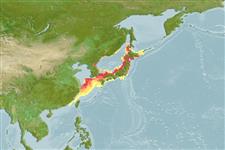Environment: milieu / climate zone / depth range / distribution range
Ecologia
marinhas demersal; intervalo de profundidade 15 - 269 m (Ref. 58496). Boreal
Northwest Pacific: Japan and the Sea of Okhotsk.
Tamanho / Peso / Idade
Maturity: Lm ? range ? - ? cm
Max length : 44.0 cm TL macho/indeterminado; (Ref. 56527); common length : 31.5 cm TL macho/indeterminado; (Ref. 56557); peso máx. publicado: 1.0 kg (Ref. 56527)
Descrição suscinta
Chaves de identificação | Morfologia | Morfometria
Espinhos dorsais (total) : 9 - 10; Raios dorsais (total) : 14 - 17; Espinhos anais: 0; Raios anais : 13 - 16.
Ciclo de vida ou comportamento de acasalamento
Maturidade | Reprodução | Desova | Ovos | Fecundidade | Larvas
External fertilization with internal insemination (Ref. 101419). This is also called 'internal gametic association' which describes another unique phenomenon of the reproductive process. In this phenomenon, the presence of the spermatozoa in the ovarian cavity is done through copulation, but the spermatozoa entry into the egg and subsequent fertilization only occurred externally when the eggs are spawned and came into contact with seawater (Ref. 101419).
Nakabo, T., 2002. Fishes of Japan with pictorial keys to the species, English edition I. Tokai University Press, Japan, pp v-866. (Ref. 41299)
Status na Lista Vermelha da UICN (Ref. 130435: Version 2024-1)
Ameaça para os humanos
Harmless
Uso pelos humanos
Ferramentas
Relatórios especiais
Baixar XML
Fontes da internet
Estimates based on models
Preferred temperature (Ref.
123201): 3.6 - 17.3, mean 12.9 °C (based on 37 cells).
Índice de diversidade filogenética (Ref.
82804): PD
50 = 1.0000 [Uniqueness, from 0.5 = low to 2.0 = high].
Bayesian length-weight: a=0.00589 (0.00281 - 0.01234), b=3.15 (2.97 - 3.33), in cm total length, based on LWR estimates for this (Sub)family-body shape (Ref.
93245).
Nível Trófico (Ref.
69278): 3.6 ±0.4 se; based on diet studies.
Resiliência (Ref.
120179): Muito baixo(a), tempo mínimo de duplicação da população maior que 14 anos (Preliminary K or Fecundity.).
Fishing Vulnerability (Ref.
59153): Low to moderate vulnerability (34 of 100).
